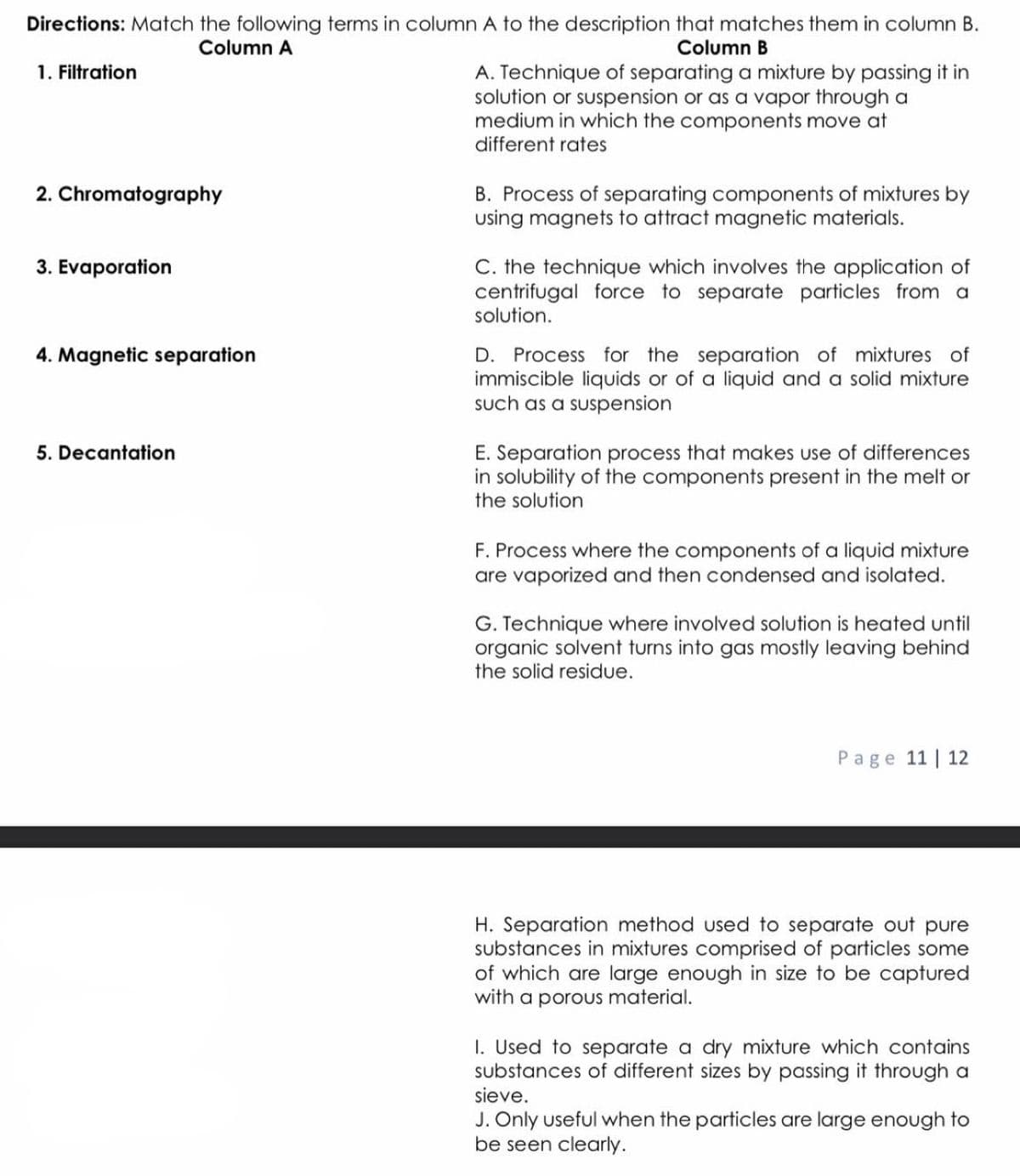irections: Match the following terms in column A to the description that matches them in column Column A Column B A. Technique of separating a mixture by passing iti solution or suspension or as a vapor through a medium in which the components move at different rates 1. Filtration 2. Chromatography B. Process of separating components of mixtures b using magnets to attract magnetic materials. C. the technique which involves the application c centrifugal force to separate particles from solution. 3. Evaporation D. Process for the separation of mixtures c immiscible liquids or of a liquid and a solid mixtur such as a suspension 4. Magnetic separation E. Separation process that makes use of difference in solubility of the components present in the melt o the solution 5. Decantation F. Process where the components of a liquid mixtur are vaporized and then condensed and isolated. G. Technique where involved solution is heated un organic solvent turns into gas mostly leaving behin the solid residue.
irections: Match the following terms in column A to the description that matches them in column Column A Column B A. Technique of separating a mixture by passing iti solution or suspension or as a vapor through a medium in which the components move at different rates 1. Filtration 2. Chromatography B. Process of separating components of mixtures b using magnets to attract magnetic materials. C. the technique which involves the application c centrifugal force to separate particles from solution. 3. Evaporation D. Process for the separation of mixtures c immiscible liquids or of a liquid and a solid mixtur such as a suspension 4. Magnetic separation E. Separation process that makes use of difference in solubility of the components present in the melt o the solution 5. Decantation F. Process where the components of a liquid mixtur are vaporized and then condensed and isolated. G. Technique where involved solution is heated un organic solvent turns into gas mostly leaving behin the solid residue.
Chapter14: Chromatography
Section: Chapter Questions
Problem 9P
Related questions
Question
Portfolio V (1-5)

Transcribed Image Text:Directions: Match the following terms in column A to the description that matches them in column B.
Column A
Column B
1. Filtration
A. Technique of separating a mixture by passing it in
solution or suspension or as a vapor through a
medium in which the components move at
different rates
2. Chromatography
B. Process of separating components of mixtures by
using magnets to attract magnetic materials.
C. the technique which involves the application of
centrifugal force to separate particles from a
solution.
3. Evaporation
4. Magnetic separation
D. Process for the separation of mixtures of
immiscible liquids or of a liquid and a solid mixture
such as a suspension
E. Separation process that makes use of differences
in solubility of the components present in the melt or
the solution
5. Decantation
F. Process where the components of a liquid mixture
are vaporized and then condensed and isolated.
G. Technique where involved solution is heated until
organic solvent turns into gas mostly leaving behind
the solid residue.
Page 11 | 12
H. Separation method used to separate out pure
substances in mixtures comprised of particles some
of which are large enough in size to be captured
with a porous material.
1. Used to separate a dry mixture which contains
substances of different sizes by passing it through a
sieve.
J. Only useful when the particles are large enough to
be seen clearly.
Expert Solution
This question has been solved!
Explore an expertly crafted, step-by-step solution for a thorough understanding of key concepts.
Step by step
Solved in 2 steps

Knowledge Booster
Learn more about
Need a deep-dive on the concept behind this application? Look no further. Learn more about this topic, chemistry and related others by exploring similar questions and additional content below.Recommended textbooks for you


Macroscale and Microscale Organic Experiments
Chemistry
ISBN:
9781305577190
Author:
Kenneth L. Williamson, Katherine M. Masters
Publisher:
Brooks Cole



Macroscale and Microscale Organic Experiments
Chemistry
ISBN:
9781305577190
Author:
Kenneth L. Williamson, Katherine M. Masters
Publisher:
Brooks Cole
